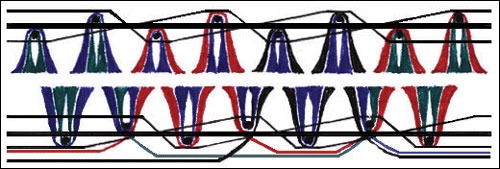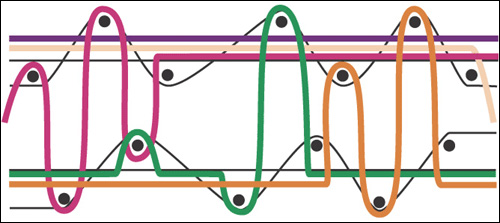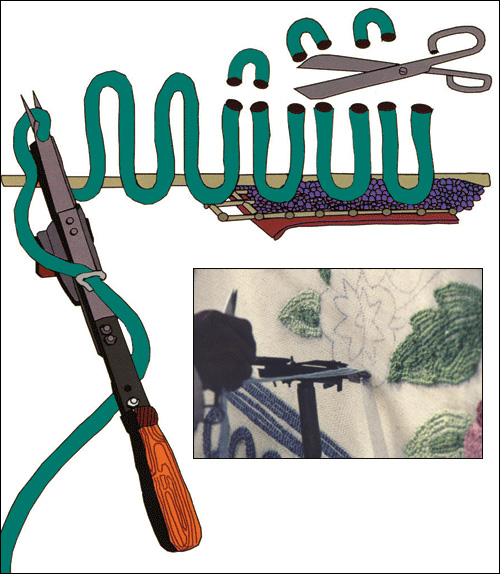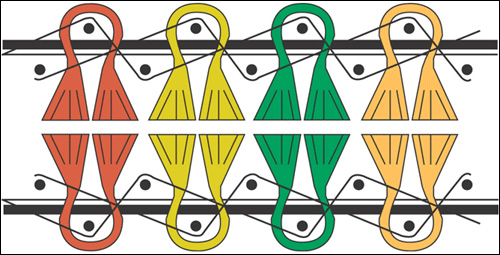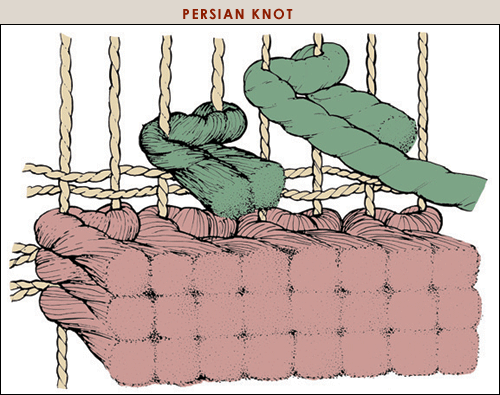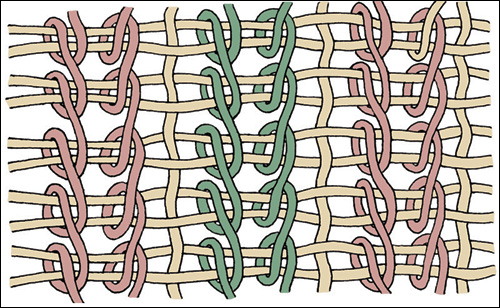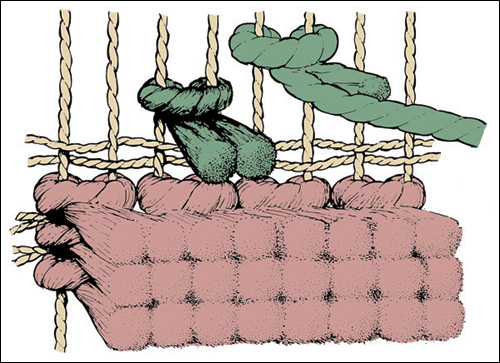Abrash
Unintentional variations in color on an area rug caused by irregular dyeing; generally appears as horizontal stripes.
Acrylic
Man-made fiber with wool-like appearance. Does not dye as well as nylon and is less durable.
Anti-Static
Carpet specially treated to reduce the effects of static electricity.
Axminster Weaving
One of the basic weaves that originated in the 1700’s in the town of Axminster, England. The pile tufts are anchored by stiff weft shots of jute, kraftcord, or synthetic fibers running across the width of the area rug or carpet. The surface yarns are usually cut and of one height. They are woven in geometric and floral patterns in combinations of colors and patterns.
Berber
A term that originally referred to the traditional handweaving of North African tribespeople who used handspun yarns made from the undyed wool of local sheep. This homespun, natural colored look has been developed on a commercial basis by carpet manufacturers.
Blend
A carpet containing a mixture of two or more fibers.
Bouclé
A heavily textured loop pile.
Chenille
A fabric with a deep fuzzy pile often used for bedspreads and rugs.
Chrome Dyes
Synthetic dyes that use potassium dichromate to form a permanent bond between yarn and the dye. More widely used than vegetable dyes because they are colorfast.
Contemporary
Non-traditional style category. The designs range from tailored architectural geometrics to free-form asymmetrical styles.
Cotton
A product of the cotton plant. The fibers form within the cotton boll, or the seedpod. Over several months, the cotton boll grows to about the size of a ping pong ball. Inside, the moist cotton fibers are formed around the cottonseeds. Once processed and spun, cotton fibers are soft and lightweight. They also suck up moisture and dry quickly. At Couristan, we use cotton as a binding thread to help form the backing and fringes found in most of our area rugs.
Cross-Woven
Click to See Cross-Woven
Crystal-Point Finish
The tip of the yarn is finished with a crystal-like point, not cut “straight across” as in ordinary rugs. This adds greater definition to the design and a shimmer-like finish to the entire rug. “Crystal-Point Finish” is an exclusive Couristan feature.
Cut-Pile
Cut-Pile is a smooth classic finish often known as “velour” or “velvet” pile, ideal for bringing a luxurious and sensual feel to rooms. The tops of the loops of wool are cut and the yarn is twisted and set to produce tufts of yarn that stand upright and produce a smooth, even surface.
Denier
System for expressing linear density, equal to the mass in grams per 9,000 meters of yarn, filament, fiber or other textile strand. Denier is a direct numbering system – the higher the denier, the larger the yarn or fiber.
Density
Refers to the amount of pile yarn in the carpet and the closeness of the tufts. The denser or more tightly packed the yarn, the better.
Eight-Frame
Click to See Eight-Frame
Embossed
A process of carving around a design or symbol to enhance the look of the rug. Commonly done in some Chinese and Tibet rugs.
Faux Silk
“Artificial silk” is usually a synthetic, such as polyester, or cellulosic fiber such as viscose/rayon. Mercerized cotton is also used as a silk look-alike. Also called art silk, faux silk is usually used as small accents or in a short, dense pile construction.
Field
Central part of a rug design generally surrounded by a border.
Flat Weave
Weaving in which no knots are used. The weft strands are simply passed through the warp strands. Dhurries are flat woven rugs that originated in India and are usually made of cotton or wool. Kilims are generally finer, tapestry-like flat weaves.
Flattening
Most carpet styles and textures can show some effect from pile flattening or a change in pile lay due to frequent walking or other forms of traffic. This change of pile lay is often more noticeable in plain, cut-pile carpets due to the difference in the visual appearance of the side and top of the tuft. Vacuuming and pile lifting will revive the pile temporarily, as will wet or dry methods of cleaning. After a period, however, the effect will again be evident.
Frames
Racks that hold spools of yarn on a Wilton loom. Each frame holds a separate color creel. Thus an eight-frame Wilton weaves an eight-color rug.
Frieze
Also called hard twist, this carpet pile uses highly twisted yarn for a more textured cut-pile effect.
Gauge
The number of ends of pile yarn per unit length cut across the width of the carpet.
Ground
Background color that sets off the principle design motif of the rug. Hand tactile qualities of a fabric including softness, stiffness, rough, scratchy, etc.
Hand
Tactile qualities of a fabric including softness, stiffness, rough, scratchy, etc.
Hand-Hooked/Hand-Tufted
Click to See Hand-Hooked/Hand-Tufted
Hand-Woven
Those rugs woven either on the hand, or hand and foot power-loom. To determine if the rug is hand-woven, look at the back of rug near the fringe, if the ridges run parallel, the rug is hand-woven.
Handmade
Area rugs that are made by hand and are entirely hand-knotted or hand-loomed.
Hard Twist (Cut-Pile)
This style of carpet, also called Frieze cut-pile, features yarn twisted to a high degree and then set. The hardwearing texture minimizes tracking (footprints), shading (irregular light and dark areas in the pile) and shedding, making it a popular, practical carpet.
Heat-Set
Twisted yarns are treated with heat to retain their “permanent wave” for better performance and appearance retention.
Jute
You are probably familiar with the brown woven cloth used for burlap sacks. Burlap is woven jute cloth. Most jute is grown and harvested in the moist heat of Bangladesh, India and China. Processing involves wetting the long jute plants and then stripping the fibers from the stalks. Once separated into fibers, jute can be spun into yarn, woven or made into rope. Although jute is of relatively poor quality, it is plentiful and inexpensive, in fact there is more jute processed than any other natural fiber except cotton. At Couristan, we use jute to help form the backing found in most of our area rugs.
Knot
The basic structural unit of the pile rug, knots vary according to local and tribal weaving traditions, with the two main types being symmetrical (Turkish) and asymmetrical (Persian) varieties.
Knot Count
The number of knots in a square inch of a rug. Handmade Chinese rugs are often described in terms of “line”. A 65 line rug would have 65 knots per foot of length, and 29 knots per square inch.
Knots Per Square Inch
Number of knots per square inch rates the knot quality.
Knotted Pile
A type of weaving in which tufts or wool forming the pile are wrapped around one or more (usually two) warps to project at right angles to the plane of the weaving. They are “tied” individually, a transverse row at a time, and are held in place by ground wefts. The process is to be distinguished from the making of hooked rugs in which tufts of wool are poked into a pre-existing loosely woven fabric. In carpet weaving, knots can only be inserted as weaving proceeds and not afterwards. The “knots” are not true knots though they do encircle one or more of the wefts to form a highly durable fabric. The pile “knots” cannot be pulled out as they can when the tufts of pile are simply looped around the warps.
There are two basic types of knot: the Persian, Senneh, open or asymmetrical knot; the Turkish, Ghiordes, closed or symmetrical knot. The Persian knot is well suited to fine, detailed work and is found in all court rugs, almost all urban workshop rugs and some Persian village rugs; it is also used by some tribal groups in Persia and neighboring countries. The Turkish knot makes for a more durable fabric and is used throughout Turkey and the Caucasus, by most tribal weavers outside Persia, some Persian tribal weavers and in many villages in northern and western Persia.
Latex
A water emulsion of a synthetic rubber or plastic obtained by polymerization and used especially in coatings and adhesives.
Locked-In-Weave
Click to See Locked-In-Weave
Loom
Structure that allows area rugs to be woven by holding the warp strands taut; looms can be vertical or horizontal, fixed or mobile.
Loop Pile
Level loop pile is a hard wearing surface formed on continuous loops of yarn of uniform length, designed to minimize tracking.
Luster
Brightness or sheen of fibers, yarns.
Multi-Level Loop Pile
Carpet with loops of yarn at different heights creating a sculptured effect.
Nap
The pile yarns or the surface of a rug or carpet.
Needlepoint
A rug making technique made with wool yarns worked on canvas using the same method as a needlepoint pillow.
New Zealand Wool
Is a superb natural product produced in an environmentally responsible, energy-efficient and safe way. The well-known high quality of New Zealand wool is based on long-term investment in scientific sheep breeding, as well as agricultural land management techniques. This ensures that New Zealand wool is consistently of uniform quality, free from vegetable and chemical contaminants, and is the cleanest, whitest wool available, enabling the widest ranges of different yarn and rug styles to be produced.
Nylon
Durable synthetic fiber that also has good dyeing characteristics. Nylon yarns can be solution dyed, skein dyed and/or space dyed. Durable synthetic fiber which also has good dyeing characteristics. Nylon yarns can be solution dyed, skein dyed and/or space dyed.
Patina
The surface appearance of a rug usually mellows with age or use.
Persian Knot
Click to See Persian Knot
Pile
The surface of the area rug, generally made of wool, formed by the cut ends of the knots. The length of the pile is usually evened off in two shearing operations, one during weaving and one on completion of the area rug.
Pile Height
The height of the pile, as measured in decimal parts of one inch, from the top surface of the back to the top surface of the pile. The higher the number, the higher the pile.
Pile Weight
The weight of pile yarn per square yard of carpet.
Pilling
Small balls of fluff.
Plush
A cut-pile carpet in which the tuft ends all blend together.
Ply
The thickness of an area rug or carpet yarn. 3 ply means that each tuft of yarn consists of 3 yarns spun together to form the tuft.
Point
One tuft of pile.
Polyester
Synthetic fiber most often used in staple spun yarns.
Polypropylene/Olefin
Synthetic fiber used extensively in machine-made rugs. This low-cost fiber is colored in the pellet phase of production. Performs best when heat-set and/or used in a dense construction.
Power-Loom
A loom operated by mechanical or electronic power.
Primary Backing
In tufted carpet, this is the woven backing into which tufts are inserted by needles. Tufts are bonded into place with latex applied on the reverse side.
Savonnerie
Made in France, this is a hand-knotted pastel rug with a floral medallion set on an open field with broken borders. This rug is the model for many of today’s Indian and Persian rugs.
Saxony
A dense cut pile carpet made with heavy yarns treated so each tuft end can be easily seen. A shorter pile than shag pile and generally a closer construction.
Secondary Backing
In tufted carpet, an additional backing is bonded onto the primary backing with latex.
Semi-Worsted
An extra step in wool processing that combs out shorter fibers resulting in durable and lustrous yarns.
Setting
A process used to set the twist in yarns when they are to be used in cut-pile textures requiring good tuft definition.
Shading
A change in the appearance of an area rug due to localized distortions of the fibers, tufts or loops. Shading is not a change in color or hue, but a different reflection.
Shedding
The process of losing loose fiber from the pile yarn of a new carpet. It is not harmful to the carpet. Also called fluffing.
Solution Dyed
A method of dyeing synthetic fiber in which pigment is added to the nylon or polypropylene chip before it is extruded as filament yarn.
Space Dyed
Yarn colored in sections of different colors before being tufted or woven into a rug. Abrash effects can be created with space dyed yarns. Space dyeing is frequently applied to nylon fibers.
Sprouting
When ends of backing material such as jute appear on the pile surface.
Static
The build-up of an electric charge when a person walks over a carpet, which is subsequently discharged. It occurs on natural and synthetic fibers, and is dictated by humidity.
Sumac Weave
Click to See Sumac Weave
Textured Loop Pile
With loops of differing pile height, textured loop has a unique sculptured look. Like level loop pile, this hard wearing texture minimizes tracking.
Tibetan Knot
A distinctive rug-weaving technique now used in other regions, as well as in Tibet. A temporary rod, which establishes the length of pile, is put in front of the warp. A continuous yarn is looped around two warps and then once around the rod. When a row of loops is finished, then the loops are cut to create the pile. This method produces a slightly ridged surface.
Tip-Shear
These carpets have a unique patterned or textured appearance achieved by having some loops of yarn cut and some uncut. This luxurious finish minimizes footprints and gives your floor classic, fashionable comfort.
Tone-On-Tone
Two or more shades of the same hue achieved by combining two ends of different shades, two different yarns of the same color or cut-pile and looped pile of the same color.
Tracking
Tracking is the effect of imprints on your carpet left by feet. It is more common on cut-pile than loop pile surfaces but it is temporary and will disappear after vacuuming.
Traditional
Styling designation that refers to long established patterns in the Oriental/Persian or classic European schools. In new rugs, traditional designs are produced either in modern colorations or in colors that replicate antique rugs.
Transitional
A broad style category that falls between traditional and contemporary. Many floral patterns are included in this category.
Triple-Frame
Click to See Triple-Frame
Tufted
An area rug or carpet fabricated by pushing surface yarns through a previously constructed sheet of primary backing to which a secondary back usually is laminated.
Turkish Knot
Click to See Turkish Knot
Twist
The winding of the yarn around itself. The twist should be neat and well defined. A tighter twist provides enhanced durability and in the case of patterned goods, a more delineated design.
Vegetable Dyes
Dyes made from plants and bark. They produce unusual shades of blue, green and other colors. They contain no synthetic chemicals and, due to their natural ingredients, tend to fade faster than chrome dyes.
Velour
Cut-pile carpet with a uniform, velvet-like surface.
Warp
The yarn stretched vertically on a hand-knotted area rug. The knots forming the pile are tied on the warp threads.
Washing
A euphemism for the chemical treatment of woolen rugs, which tones down the colors, dulls the whites, makes the pile glossy and gives them a soft and supple texture. The process in some respects imitates the effect of ageing and undoubtedly makes rugs more saleable, but the changes are irreversible and the process is not favored by purists who believe that rugs should be allowed to age naturally.
Weft
The yarn that the weaver passes across the width of the rug between warp threads. The weft threads maintain the knots of the pile in place.
Wilton Weave
The yarn that the weaver passes across the width of the rug between warp threads. The weft threads maintain the knots of the pile in place.
Wool Sisal
Wool sisal-look carpets are very popular. The fashionable raw, woven texture of sisal (coir and seagrass) is stylishly translated into the warmth, softness and durability of New Zealand wool.
Woven Carpets
Woven carpets are made on a weaving loom – the backing threads and pile are woven at the same time, so the tufts are anchored in place and a strong interwoven structure is created. Traditional methods originating in the 16th century, Axminster and Wilton are both well-known woven carpets. Woven carpets can offer a wider range of patterns and are slower to make than tufted carpets.


